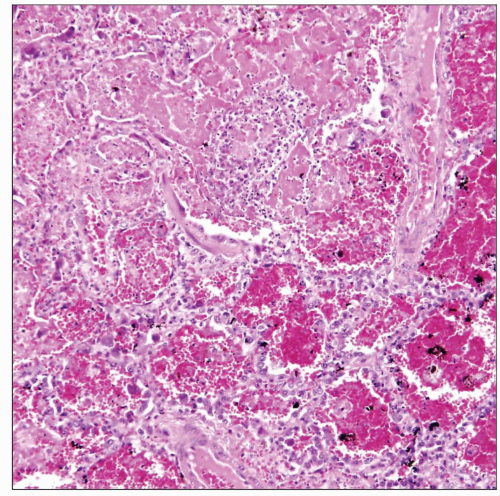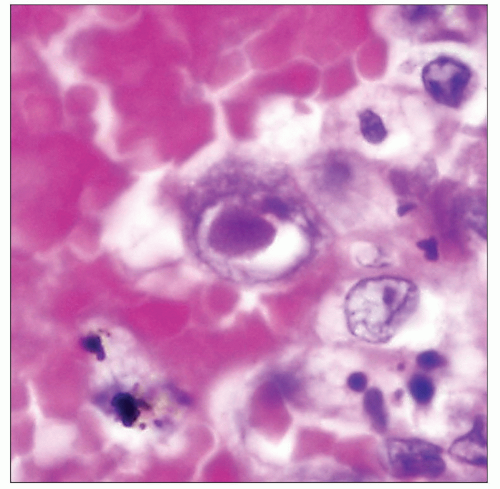Herpes Simplex Virus
Key Facts
Terminology
Lung infection caused by double-stranded DNA herpes simplex virus-1
Clinical Issues
In infants, disease is transmitted by mother during passage of fetus through infected birth canal
In adults, infection may be due to contamination from mucocutaneous sources or reactivation of latent infection
Microscopic Pathology
Pattern of involvement in lung may present as necrotizing pneumonia or as diffuse interstitial pneumonitis
HSV diffuse interstitial pneumonitis closely resembles diffuse alveolar damage (DAD)
Infected cells are characterized by presence of intranuclear inclusions
Cowdry type A inclusions: Eosinophilic intranuclear inclusion separated from nuclear membrane by a halo
Cowdry type B inclusions: Homogeneous, amphophilic, and glassy intranuclear inclusions
Multinucleated epithelial cells with multiple eosinophilic intranuclear inclusions may also be present
Ancillary Tests
Antibodies to HSV using formalin-fixed paraffin-embedded tissue sections are quite sensitive
Virus particles are encapsulated and targetoid and measure 100-110 nm by electron microscopy
 Histologic appearance of hemorrhagic necrotizing pneumonia in a patient with herpes simplex virus (HSV) infection shows extensive destruction of lung parenchyma with fibrinous intraalveolar exudates. |
TERMINOLOGY
Abbreviations
Herpes simplex virus (HSV)
Definitions
Lung infection caused by double-stranded DNA herpes simplex virus-1
ETIOLOGY/PATHOGENESIS
Infectious Agents
Most cases of neonatal disease are acquired from infected mothers during labor
Adult HSV pneumonia is most often caused by inhalation of viral particles from mucocutaneous lesions in oropharynx
CLINICAL ISSUES
Epidemiology
Incidence
HSV pneumonia is seen in neonates as well as in immunosuppressed patients
Incidence of neonatal HSV infection is approximately 1 in every 3,000 deliveries
Disseminated HSV infection develops in approximately 25% of infected neonates
Age
Wide age range, from neonates to elderly patients
Presentation
HSV pneumonia is most often preceded by mucocutaneous infection
Newborn infants, severely immunosuppressed or burned patients, and patients with trauma are at highest risk for infection
Infants with disseminated neonatal infection show signs and symptoms about 1 week after birth
Clinical picture in neonatal infection resembles bacterial sepsis with pneumonia, shock, and disseminated intravascular coagulation
In adults, disseminated infection produces acute hemorrhagic bronchopneumonia
Ulcerative necrotizing tracheobronchitis can also accompany pneumonia in adults
Natural History
HSV has worldwide distribution with no recognizable gender or racial predilection
In infants, disease is transmitted by mother during passage of fetus through infected birth canal
In adults, infection may be due to contamination from mucocutaneous sources or reactivation of latent infection
Disease is associated with high mortality if left untreated
Treatment
Drugs
Antiviral therapy (acyclovir, valacyclovir, famciclovir, etc.)
Foscarnet is treatment of choice in acyclovir-resistant patients
Prognosis
Primary HSV infection of upper respiratory tract usually resolves spontaneously without treatment
Infection in immunosuppressed patients requires treatment with antiviral drugs
Disseminated disease in neonates carries 30% mortality rate
IMAGE FINDINGS
Radiographic Findings
Stay updated, free articles. Join our Telegram channel

Full access? Get Clinical Tree



